Which of the following blood vessels carries blood away from the heart to other organs?
- arteries
- capillaries
- venules
- arterioles
- veins
A
Which of the following blood vessels carries blood from the tissues back to the heart?
- arteries
- arterioles
- aorta
- veins
- capillaries
D
Which layer of the arterial wall is responsible for vasoconstriction?
- tunica interna
- tunica media
- tunica externa
- tunica albuginea
- tunica fascia
B
Which layer of the arterial wall is primarily composed of elastic and collagen fibers?
- tunica interna
- tunica media
- tunica externa
- tunica albuginea
- tunica fascia
C
When an artery or arteriole is damaged, its smooth muscle layer contracts producing
- tear in the vessel.
- new vessel branching off the artery or arteriole.
- a vascular spasm.
- tetanus.
- increased blood flow to the damaged vessel.
C
Elastic arteries function as
- vasodilators.
- conduits to the tissues of the trunk only.
- barriers to microcirculation.
- pressure reservoirs.
- vasoconstrictors.
D
In resting individuals, these vessels serve as a large blood reservoir from which blood can be quickly diverted to other vessels as needed.
- Arteries and arterioles
- Arterioles and capillaries
- Venules and capillaries
- Veins and venules
- Aorta and veins
D
This type of blood vessel plays a key role in regulating blood flow into capillaries.
- arteries
- arterioles
- venules
- veins
- aorta
B
Which of the following structures are found in veins but NOT in arteries?
- tunica externa
- tunica media
- tunica interna
- valve
- lumen
D
Capillaries are also referred to as
- exchange vessels.
- vasoconstrictors.
- vasodilators.
- pressure reservoirs.
- distributing vessels.
A
Which of the following is the most important method of capillary exchange?
- diffusion
- transcytosis
- bulk flow
- primary active transport
- secondary active transport
A
Which of the following structures is used to control the flow of blood through a capillary bed?
- thoroughfare channels
- precapillary sphincters
- postcapillary sphincters
- venules
- valves in veins
B
Which of the following types of tissues contains continuous capillaries?
- skeletal muscle
- smooth muscle
- connective tissue
- lungs
- all of these choices
E
The alternate route of blood flow to a body part through an anastomosis is called
- a thoroughfare channel.
- a blood reservoir.
- a detour route.
- collateral circulation.
- microcirculation.
D
The largest driving force for pulling fluid from the interstitial spaces back into the capillaries is
- interstitial fluid hydrostatic pressure.
- interstitial fluid osmotic pressure.
- blood colloid osmotic pressure.
- blood hydrostatic pressure.
- glomerular hydrostatic pressure.
C
The pressure-driven movement of fluids and solutes from blood into interstitial fluid is called
- reabsorption.
- filtration.
- bulk flow.
- osmosis.
- transcytosis.
B
The volume of blood that circulates through the systemic (or pulmonary) blood vessels per minute is called
- stroke volume.
- tidal volume.
- cardiac output.
- cardiac reserve.
- total peripheral resistance.
C
Cardiac output is dependent on both
- heart rate and stroke volume.
- stroke volume and systemic vascular resistance.
- heart rate and systemic vascular resistance.
- blood type and stroke volume.
- blood pressure and heart rate
A
Which of the following would NOT result in an increase in arterial blood pressure?
- Increased blood volume
- Increased sympathetic stimulation
- Increased heart rate
- Increased stroke volume
- Increased arteriolar vasodilation
E
Which of the following would NOT result in an increase in systemic vascular resistance?
- Decreased diameter of systemic arterioles
- Increased blood viscosity
- Decreased length of the systemic circulatory route
- Increased vasoconstriction of systemic arterioles
- Increased red blood cell count
C
Which of the following characteristics of blood depends mostly on the ratio of RBCs to plasma volume?
- total blood volume
- blood viscosity
- venous return
- clotting time
- immunoglobulin profile
B
Circulation time
- varies with diet.
- is set by the hypothalamus.
- in a resting human is normally 1 minute.
- depends on hormones released from the liver.
- that is lower than 20 seconds will lead to heart failure.
C
The cardiovascular center is located
- in the thoracic cavity.
- in the cerebral cortex.
- in the cerebellum.
- in the medulla oblongata.
- in the hypothalamus.
D
All of the following aid in venous return of blood to heart EXCEPT
- the skeletal muscle pump.
- the respiratory pump
- blood viscosity.
- venoconstriction
- venous valves.
C
Which of the following would be a normal response of the cardiovascular system to a decreased frequency of action potentials arising from the baroreceptors?
- Increased systemic vascular resistance
- Increased parasympathetic stimulation
- Decreased heart rate
- Decreased stroke volume
- Decreased cardiac output
A
Which of the following hormones would NOT stimulate changes that lead to an increase in arterial blood pressure?
- Atrial natriuretic peptide(ANP)
- Antidiuretic hormone(ADH)
- Aldosterone
- Angiotensin
- Epinephrine
A
When chemoreceptors in blood vessels detect high levels of carbon dioxide in the blood, they stimulate all of the following changes EXCEPT
- increased vasoconstriction of arterioles.
- increased blood pressure.
- decreased respiratory rate.
- increased sympathetic stimulation of arterioles and veins.
- increased vasoconstriction of veins.
C
The myogenic response of smooth muscle results in
- more forceful contractions when stretched.
- more forceful contractions when relaxed
- tetany.
- relaxation of smooth muscle when stretched.
- formation of new desmosomes.
A
What do the following chemicals have in common: potassium, hydrogen ions, lactic acid, nitric oxide, and adenosine?
- All potent vasoconstrictors.
- All potent vasodilators.
- Used to stimulate smooth muscle contractions.
- Directly regulate the cardiac center of the hypothalamus.
- Decrease systolic blood pressure.
B
In which of the following types of blood vessels is blood pressure NOT pulsing?
1. Arteries
2. Capillaries
3. Arterioles
4. Venules
- 1 only
- 2 only
- 3 only
- 4 only
- Both 2 and 3
E
Abnormal conditions such as atherosclerosis and patent ductus arteriosus cause an large increase in the
- blood colloid osmotic pressure.
- central venous pressure.
- pulse pressure.
- venular hydrostatic pressure.
- capillary hyrdostatic pressure.
C
This type of shock is due to decreased blood volume.
- Hypovolemic
- Cardiogenic
- Vascular
- Obstructive
- Neurogenic
A
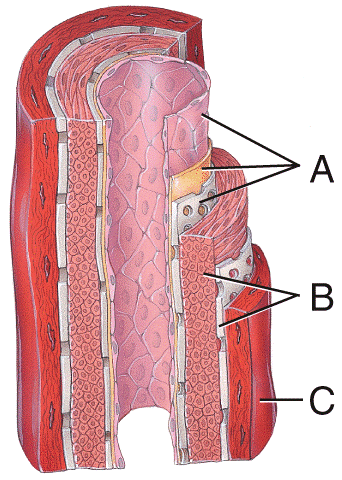
Which of the labeled layers in the diagram of the arterial wall consists mainly of elastic fibers and smooth muscle fibers?
- A
- B
- C
- A and B
- A, B and C
B

Which of the labeled layers in the diagram of the arterial wall is composed of a simple squamous epithelium, a basement membrane and a layer of elastic tissue?
- A
- B
- C
- A and B
- A, B, and C
A
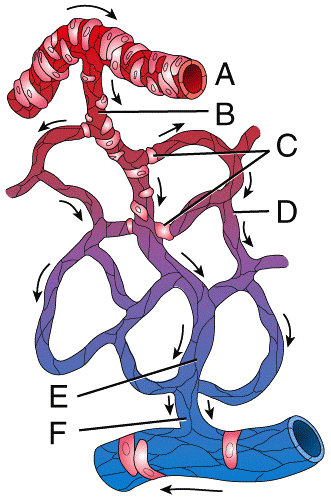
Which labeled structure in the figure is a metarteriole?
- A
- B
- D
- F
- E
B

Which labeled structure in the figure is a capillary?
- A
- B
- C
- D
- E
D

Which labeled structure in the figure is a precapillary sphincter?
- A
- B
- C
- D
- E
C
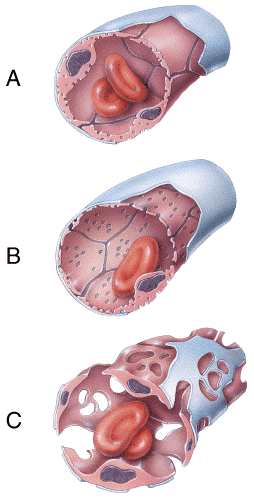
Which of the capillaries shown in the figure has an incomplete or absent basement membrane?
- A
- B
- C
- A and B
- A, B, and C
C

Which of the types of capillaries shown in the figure is commonly found in the kidneys, villi of the small intestine, choroid plexuses, and some endocrine glands?
- A
- B
- C
- A and B
- B and C
B
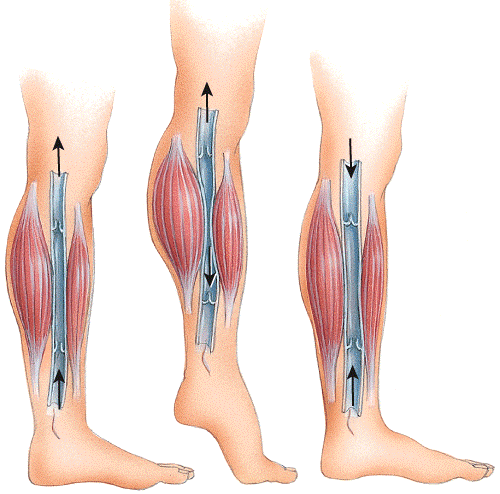
What physiological process is depicted in this figure?
- Venous blood blockage
- Skeletal muscle pump
- Respiratory pump
- Thoroughfare channels
- Anastomosis
B
What do following arteries have in common: superficial temporal artery, brachial artery and common carotid artery?
- They are all areas where Korotkoff sounds cannot be heard.
- They are all only found on the left side of the body.
- They are all common pulse points.
- They all contain baroreceptors.
- They all deliver blood to structures in the head.
C
Which of the following would NOT occur in response to hypovolemic shock?
- Activation of the renin-angiotensin-aldosterone (RAA) system.
- Secretion of antidiuretic hormone (ADH)
- Activation of the sympathetic division of the ANS.
- Release of atrial natriuretic peptide (ANP).
- Release of local vasodilators.
D
All the veins of the systemic circulation eventually drain into the
- superior vena cava.
- inferior vena cava.
- coronary sinus.
- superior and inferior vena cava.
- superior and inferior vena cava and coronary sinus.
E
The pulmonary trunk divides into
- brachiocephalic trunk and left subclavian artery
- right and left subclavain arteries.
- right and left pulmonary veins.
- right and left pulmonary arteries.
- right and left common carotid arteries.
D
In fetal circulation, what is the opening between the right and left atria called?
- Ductus venousus
- Umbilicus
- Fossa ovalis
- Foramen ovale
- Ductus arteriosus
D
Which of the following vessels is a pulse point found at the wrist?
- Radial artery
- Subclavian artery
- Axillary artery
- Cephalic artery
- Palmar artery
A
Which of the following vessels supplies blood to the intestines?
- Radial artery
- Subclavian artery
- Mesenteric artery
- Coronary artery
- Popliteal artery
C
Which of the following vessels supplies blood to the kidneys?
- Hepatic artery
- Renal artery
- Mesenteric artery
- Coronary artery
- Popliteal artery
B
Which of the following vessels drains blood from the lower leg?
- Jugular vein
- Superior vena cava
- Tibial vein
- Coronary vein
- Inferior mesenteric vein
C
Which of the following vessels drains blood from the head and neck?
- Median cubital vein
- Inferior vena cava
- Axillary vein
- Femoral vein
- Jugular vein
E
Which of the following vessels carries the venous blood from the lower body into the right atrium?
- Inferior vena cava
- Superior vena cava
- Tibial vein
- Coronary vein
- Iliac vein
A
When the umbilical cord is tied after birth, the umbilical arteries close by filling in with
- placental fluid.
- platelet plugs.
- connective tissue.
- smooth muscle.
- epithelial tissue.
C
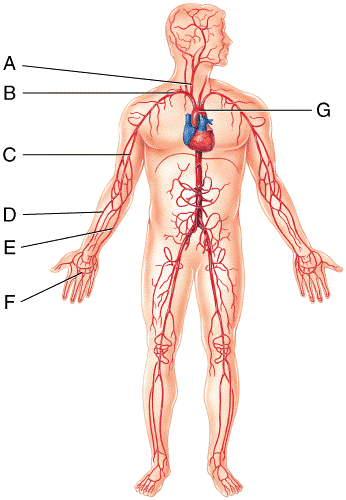
Which vessel in the figure is labeled “E”?
- right ulnar artery
- right subclavian artery
- right radial artery
- right brachial artery
- right axillary artery
A

Which vessel in the figure is labeled “D”?
- right ulnar artery
- right subclavian artery
- right radial artery
- right brachial artery
- right axillary artery
C

Which vessel in the figure is labeled “B”?
- right ulnar artery
- right subclavian artery
- right radial artery
- right brachial artery
- right axillary artery
B

Which vessel in the figure is labeled "C"?
- right ulnar artery
- right subclavian artery
- right radial artery
- right brachial artery
- right axillary artery
D

Which vessel in the figure is labeled "A"?
- right subclavian artery
- right radial artery
- right common carotid artery
- right brachial artery
- right axillary artery
C

Oxygenated blood is directly carried into the vessel labeled "F" by both
- right subclavian artery and right axillary artery.
- right radial artery and right ulnar artery.
- right common carotid artery and brachiocephalic trunk.
- right brachial artery and right ulnar artery.
- right axillary artery and right ulnar artery.
B

Oxygenated blood is carried directly into the vessel labeled E by the
- right subclavian artery.
- right radial artery.
- right common carotid artery.
- right brachial artery.
- right axillary artery.
D
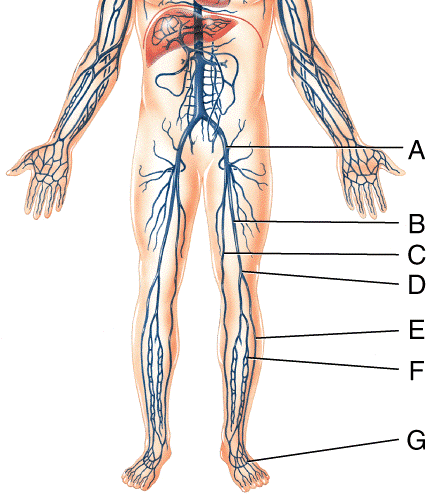
Which vessel in the figure is labeled "B"?
- left femoral vein
- left great saphenous vein
- left popliteal vein
- left anterior tibial vein
- left fibular vein
A

Which vessel in the figure is labeled "C"?
- left femoral vein
- left great saphenous vein
- left popliteal vein
- left anterior tibial vein
- left fibular vein
B

Which vessel in the figure is labeled "D"?
- left femoral vein
- left great saphenous vein
- left popliteal vein
- left anterior tibial vein
- left fibular vein
C

Which vessel in the figure is labeled "F"?
- left femoral vein
- left great saphenous vein
- left popliteal vein
- left anterior tibial vein
- left small saphenous vein
D

Which vessel in the figure is labeled "E"?
- left femoral vein
- left great saphenous vein
- left popliteal vein
- left anterior tibial vein
- left small saphenous vein
E

Deoxygenated blood draining from the vessel labeled “F” in the figure, immediately travels into the
- left small saphenous vein.
- left femoral vein.
- left great saphenous vein.
- left posterior tibial vein.
- left popliteal vein.
E

Deoxygenated blood draining from the vessel labeled “E” in the figure, immediately travels into the
- left small saphenous vein.
- left femoral vein.
- left anterior tibial vein.
- left posterior tibial vein.
- left popliteal vein.
E
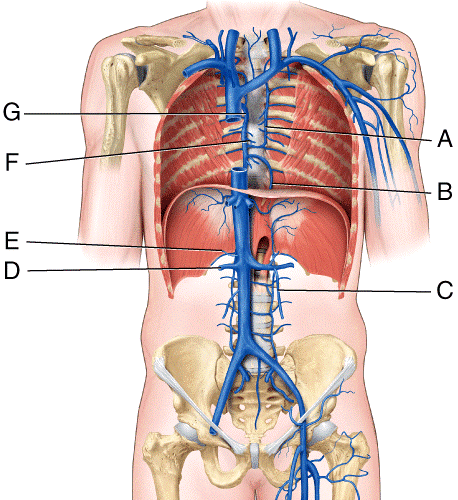
Which vessel in the figure is labeled "C"?
- accessory hemiazygos vein
- hemiazygos vein
- left gonadal vein
- right renal vein
- right suprarenal vein
C

Which vessel in the figure is labeled "D"?
- accessory hemiazygos vein
- hemiazygos vein
- right renal vein
- right suprarenal vein
- pericardial vein
C

Which vessel in the figure is labeled "B"?
- accessory hemiazygos vein
- hemiazygos vein
- right suprarenal vein
- pericardial vein
- azygos vein
B

Which vessel in the figure is labeled "A"?
- accessory hemiazygos vein
- hemiazygos vein
- right suprarenal vein
- pericardial vein
- azygos vein
A

Which vessel in the figure is labeled "G"?
- accessory hemiazygos vein
- hemiazygos vein
- right suprarenal vein
- pericardial vein
- azygos vein
E

Which vessel in the figure is labeled "F"?
- accessory hemiazygos vein
- hemiazygos vein
- right suprarenal vein
- pericardial vein
- azygos vein
D
During embryonic development, blood vessels are formed by
- endodermal cells.
- pluripotent stem cells.
- angioblasts.
- fibroblasts.
- osteoblasts.
C
During embryonic development, blood cells are formed from
- endodermal cells.
- pluripotent stem cells.
- angioblasts.
- fibroblasts.
- osteoblasts.
B
Normal blood pressure for a young adult male is
- 120/80.
- 130/90.
- 80/120.
- 100/80.
- 150/85.
A
Which of the following types of blood vessels have high pulsing blood pressure?
- arterioles
- capillaries
- venules
- veins
- vena cavae
A
What would the pulse pressure and mean arterial pressure be for an individual with a blood pressure of 120/80?
- 40; 100
- 40; 93.3
- 40; 103.3
- 200; 100
- 100; 200
B
Which of the following effectors would NOT be activated as described below in response to hypovolemic shock?
- Adrenal cortex releases aldosterone.
- Kidneys conserve salt and water.
- Heart rate increases.
- Systemic arterioles vasodilate.
- Heart contractility increases.
D
The pulmonary circulatory route carries blood from the
- right atrium to the right ventricle .
- right ventricle to the left atrium.
- left atrium to the left ventricle.
- left ventricle to the right atrium.
- left ventricle to the coronary sinus.
B
All of the following changes are commonly observed in the cardiovascular system in response to aging EXCEPT
- decreased cardiac output.
- increased compliance of the aorta.
- loss of cardiac muscle strength.
- decline in maximum heart rate.
- increased systolic blood pressure.
B
Which of the following categories would an individual with a blood pressure of 145/95 be placed in?
- Normal
- High normal
- Prehypertension
- Stage 1 hypertension
- Stage 2 hypertension
D
Which of the following categories of hypertension drugs lower blood pressure by blocking formation of angiotensin II, which results in vasodilation and decreased aldosterone secretion?
- Diuretics
- ACE inhibitors
- Beta blockers
- Calcium channel blockers
- Anabolic steroids
B